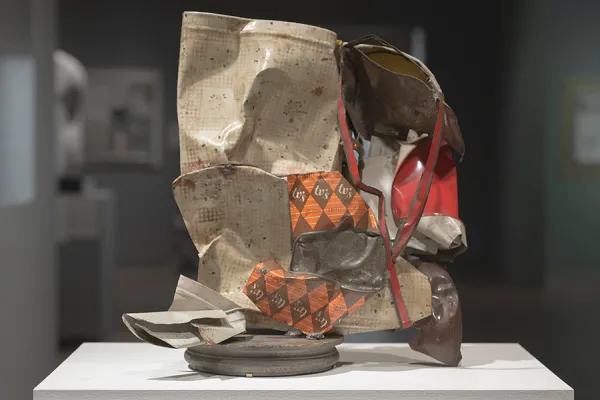New Acquisition for Museum of Art
Smith Arts

Published September 20, 2013
The Museum of Art announced this week the acquisition of Homer, an early sculpture by the major 20th-century American artist John Chamberlain (1927–2011). The purchase was made possible by a generous bequest from Isabel Brown Wilson ’53, a distinguished art philanthropist from Houston, Texas, and long-time donor to Smith, the Brown Fine Arts Center and the Museum of Art.
The acquisition of Homer realizes Wilson’s intention to enable the museum to acquire an important 20th-century American artwork for the permanent collection, reflecting her personal artistic taste as well as her commitment to supporting the academic interests of Smith faculty and students. Among many volunteer and philanthropic activities, Wilson has served Smith in various capacities. She was a member of the College Board of Trustees from 1993 to 2003 and was a valued adviser to the Museum or Art as a member of the Visiting Committee for many years.
With her sister, the late Maconda Wilson, and cousin, Louisa Stude Sarofim ’58, Isabel Brown Wilson donated $14 million to Smith through the Brown Foundation in 1997. It remains one of the largest gifts in the college’s history. Of that amount, $10 million went toward a comprehensive renovation of the Fine Arts Center that created expanded gallery space, new classrooms, better storage areas in the museum and new space for the art department and Hillyer Art Library
Works of Pop art and the 1960s have been identified as a priority in the museum’s current collecting plan. As a bridge from Abstract Expressionist painting to Pop art, Homer will find an immediate place in the permanent collection, linking the museum’s fine group of Abstract Expressionist paintings to works from the 1960s.
Homer is currently on view in a special installation on the third floor of the museum.
John Chamberlain is an important figure in American art of the second half of the 20th century. His work is identified not only with Abstract Expressionism and Pop, but with Minimalism and sub-genres of the 1960s, including “trash art.” Chamberlain’s work is in the collections of many museums, including the Guggenheim and Museum of Modern Art in New York, N.Y., and Dia:Beacon in Beacon, New York.
Homer marks a critical moment of transition in the artist’s career and belongs to a series of brightly colored, small-scale sculptures from the late 1950s and 1960s. Constructed from crushed and folded metal domestic containers, it forecasts the work for which Chamberlain is best known: assemblages of bent and crushed car parts.
Chamberlain broke barriers by introducing color into sculpture: Homer has been aptly described as a three-dimensional Abstract Expressionist painting. Its distinctly different facades have different color palettes: one side, with bright yellows, reds, and blues, forecasts Pop colors, while the more subdued palette and imprinted text and patterns of the opposite face recall Cubist collages.
Homer was acquired by the Museum from the Rauschenberg Foundation through Gagosian Gallery in New York, N.Y. The sculpture was formerly in the personal collection of artist Robert Rauschenberg (1925-2008), who amassed an important collection of the work of three generations of American artists of the 20th century, including visual and performing artists as well as choreographers.
Homer (1960), by John Chamberlain (American, 1927-1960). Painted tin and wood base, 16 x 13 1/2 x 11 in.